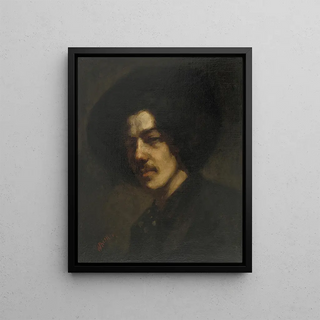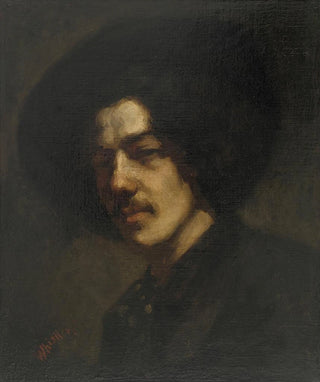Art print | Portrait of Whistler with a hat - James Abbott McNeill Whistler


View from behind

Frame (optional)
Portrait of Whistler with a Hat - James Abbott McNeill Whistler – Captivating Introduction
The "Portrait of Whistler with a Hat," an iconic work by James Abbott McNeill Whistler, embodies not only the undeniable talent of its creator but also the spirit of an era where art and personality intertwined intimately. This painting, depicting the artist himself, offers a fascinating glimpse into the artistic universe of the 19th century, while revealing the psychological nuances of a man who is both complex and charismatic. Whistler's relaxed posture, his penetrating gaze, and his distinctive hat evoke a certain elegance and introspection that captivate the viewer. Through this work, Whistler does not merely portray himself; he invites us to explore his inner world and the influences surrounding him.
Style and uniqueness of the work
Whistler's style, often associated with the Impressionist movement, transcends mere pictorial techniques to establish itself as a true visual language. In the "Art print of Whistler with a Hat," the subtleties of colors and shadows are deployed with remarkable mastery. The dark tones, interwoven with delicate lights, create an atmosphere that is both intimate and mysterious. The choice of the hat, an accessory both ordinary and symbolic, reinforces the artist's identity while adding a narrative dimension to the work. Each brushstroke seems charged with intention, revealing Whistler's personality and his relationship with the world around him. This portrait, far from being a simple representation, becomes an exploration of the human soul, a reflection of the passions and torments of its creator.
The artist and his influence
James Abbott McNeill Whistler, a prominent figure of modern art, managed to establish himself as a bold innovator within the artistic landscape of his time. His unique approach to color and composition influenced many artists, both contemporaries and future generations. Whistler championed the idea that art should be an aesthetic experience, a visual music, rather than a mere imitation of reality. By distancing himself from academic conventions, he paved the way for a new perception of art, where emotion and personal expression took the

Matte finish

View from behind

Frame (optional)
Portrait of Whistler with a Hat - James Abbott McNeill Whistler – Captivating Introduction
The "Portrait of Whistler with a Hat," an iconic work by James Abbott McNeill Whistler, embodies not only the undeniable talent of its creator but also the spirit of an era where art and personality intertwined intimately. This painting, depicting the artist himself, offers a fascinating glimpse into the artistic universe of the 19th century, while revealing the psychological nuances of a man who is both complex and charismatic. Whistler's relaxed posture, his penetrating gaze, and his distinctive hat evoke a certain elegance and introspection that captivate the viewer. Through this work, Whistler does not merely portray himself; he invites us to explore his inner world and the influences surrounding him.
Style and uniqueness of the work
Whistler's style, often associated with the Impressionist movement, transcends mere pictorial techniques to establish itself as a true visual language. In the "Art print of Whistler with a Hat," the subtleties of colors and shadows are deployed with remarkable mastery. The dark tones, interwoven with delicate lights, create an atmosphere that is both intimate and mysterious. The choice of the hat, an accessory both ordinary and symbolic, reinforces the artist's identity while adding a narrative dimension to the work. Each brushstroke seems charged with intention, revealing Whistler's personality and his relationship with the world around him. This portrait, far from being a simple representation, becomes an exploration of the human soul, a reflection of the passions and torments of its creator.
The artist and his influence
James Abbott McNeill Whistler, a prominent figure of modern art, managed to establish himself as a bold innovator within the artistic landscape of his time. His unique approach to color and composition influenced many artists, both contemporaries and future generations. Whistler championed the idea that art should be an aesthetic experience, a visual music, rather than a mere imitation of reality. By distancing himself from academic conventions, he paved the way for a new perception of art, where emotion and personal expression took the






